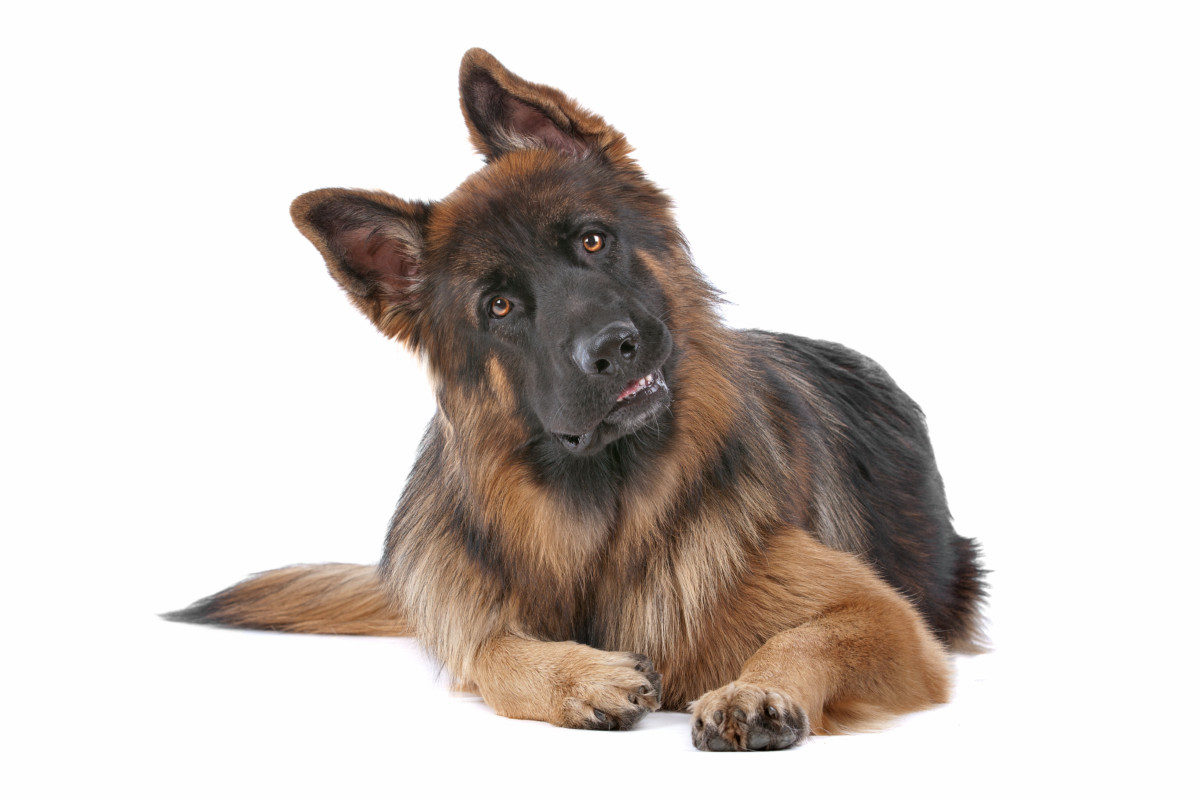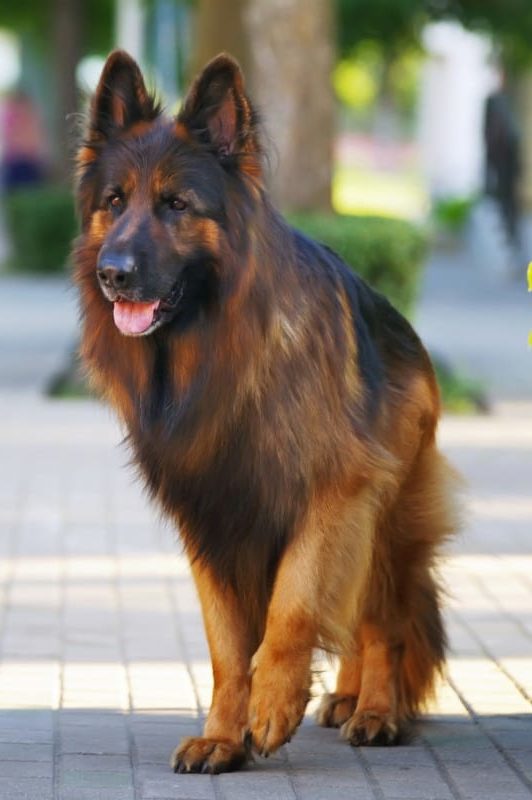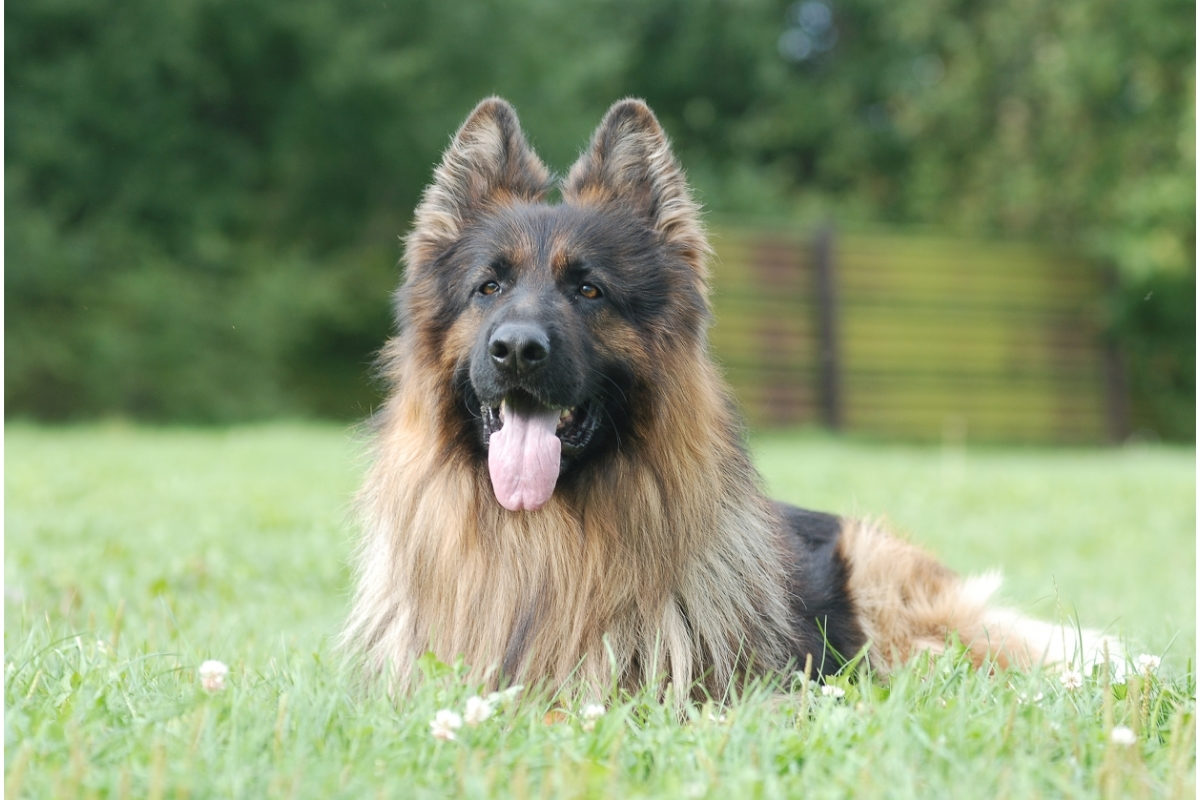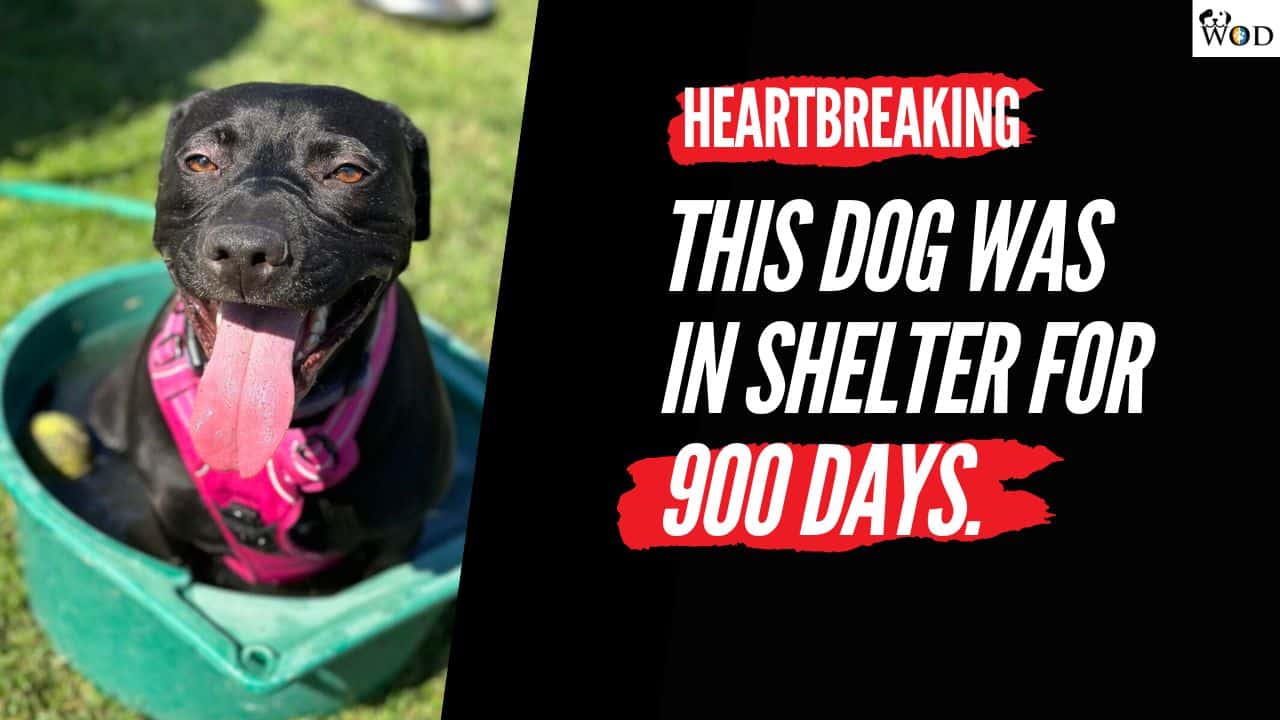Unless you were looking for a picture of a German Shepherd in a wig, you have come across this article looking for more information on the purebred long-haired German Shepherd. This variety is also known as the long-coated German Shepherd, long stock, or “coaties.”
This article will cover the long and short of owning a long-haired German Shepherd, including the dog’s history alongside its desirability, best practices for grooming, and possible health complications.
I’ll also cover frequently asked questions about long stock German Shepherds so you can be thoroughly informed about this intriguing variety.

Origin and History
| Long Haired German Shepherd | Breed Characteristics |
|---|---|
| AKC Group | Herding |
| Origin | Germany |
| Type | Companion / Working |
| Breed Size | Medium-large |
| Height | 24-26 inches (Males) 22-24 inches (Females) |
| Weight | 66-88 pounds (Males) 49-71 pounds (Females) |
| Temperament | Intelligent, Independent, Faithful, High-energy, Brave, Protective, Strong, Confident, Aloof, Devoted, Versatile, Territorial |
| Appearance | Soft topcoat that does not lie close to the body. Feathering on the ears and legs. Long and thick hair on the neck that looks like a mane. Hair is shiny and often forms a parting along the back. |
| Lifespan | 10-13 years |
| Health Issues | Bloat (GDV), Hip Dysplasia, Degenerative Myelopathy |
| Coat Colors | Black & Tan, Black & Red, Black, White (rare) |
| Coat Type | Long, Single-coated (open), Double-coated (rare) |
| Shedding | Year-round heavy shedding |
| Grooming | Moderate |
| Easy to Train | Yes |
| Exercise Needs | Medium-high |
| Hypoallergenic | No |
| Child Friendly | Yes |
| Pet Friendly | Yes |
| Good for new owners | Yes |
| Cost | $800 – $2000 (Depending on the breeder) |
What is a Long Haired German Shepherd?
Before diving into the specifics, we must appropriately define what makes a long-haired German Shepherd.
Long-haired German Shepherds have a topcoat consisting of 2-inch or longer hair and, often, no undercoat. These dogs are desired for their cuddly appearance and family-friendly look. Still, they are rarely used as studs because shorter hair is preferred by work breeders and show rings alike.
Long-haired German Shepherds are a coat type of German Shepherd that has persisted despite the breed’s founder considering longer hair a flaw. Max von Stephanitz, the father of the breed, firmly believed that long hair interferes with the dogs’ function.
The said function back then was to herd and protect sheep. Breeders, including Von Stephanitz, bred shepherd dogs to reduce coat length, but the long-coated German Shepherds didn’t get eliminated.
But why?
The long hair made for a cuddly texture which became popular with families. They are also known to have a friendlier temperament compared to the short-haired variety.
Another reason “coaties” continue to exist is unintentional production. According to Animal Genetics, the long hair in a dog is the manifestation of a recessive gene.
This means that two short-haired German Shepherds carrying a single long hair allele (gene-part) won’t have long hair themselves but can birth a puppy who inherits both long-hair alleles that make up a whole long hair gene. Consequently, short-haired dogs can give birth to long-haired ones.
So, while the intentional omission of long-coated German Shepherds from the stud pool may have brought the long hair population to around 10%, the trait hasn’t been bred out entirely.
Also, in the 1990s, the Rex franchise started featuring long-haired German Shepherds, which exposed the breed to significant audiences increasing adoption rates. As a result, breeders saw the opportunity and started to warm up to the idea of having long-haired puppies.
Hey! Watch Our YouTube Video on German Shepherd Coat Lengths…
The breed’s prominence died down within a few years of the functional breeding programs that overtook pioneering the modern German Shepherd Dog in 1899. Before that, they could be found in almost the same numbers as their short-haired counterparts.
Indeed, the long-haired varieties were used to birth the short-haired ones until there was a large enough reliable stud pool of short-haired dogs.
With the return of personal preference independence, these dogs have seen a boom in demand. Personal preferences are no longer contingent on the American Kennel Club’s approval or show-ring eligibility, which means that those who love a cuddly dog with a majestic mane won’t care that the long coat is considered a minor flaw by the AKC.
Since the AKC considers long hair a fault in German Shepherds, it doesn’t recognize them as a separate breed.
Faults in coat include soft, silky, too long outer coat, woolly, curly, and open coat.
GSD Breed Standard
Categorizing long-coated German Shepherds as a separate breed and then discriminating against them wouldn’t be a good look on the organization anyway. It would look like the AKC is dismissing an entire breed.
Now it seems like the club is promoting health and utility by holding up the standard of what makes for the perfect German Shepherd.
But since having a long coat doesn’t come with inherent medical complications, the AKC’s view of ‘flaw’ matters only in the realm of show rings. Since dog shows look up to the AKC for enrollment standards, whatever the club considers flawed doesn’t get to enter dog shows.
However, that doesn’t mean “coaties” don’t have many uses. They are great for different tasks for most households but don’t have the agility or the economy required to perform on a national level. That’s why the German Shepherds used by the police and the military are usually short-haired.
Check Out This Video on The Long Haired GSD…
Long coat German Shepherds may look different from what now seems to be the standard. However, they are still purebred and match everything else of an ordinary variety except the coat length.
Having long hair, for example, won’t open up your German Shepherd to health complications. However, that doesn’t mean they aren’t prone to medical conditions. As per Pet Health Network, German Shepherds, with long coats or short ones, are equally as vulnerable to the following conditions:
- Hip and elbow dysplasia
- Hemophilia
- Degenerative disk disease
- Epilepsy
- Diabetes
- Bloat (GDV)
That said, these diseases don’t have equal probability, and your dog could be more prone to some conditions than others.
Long-haired German Shepherds are rare but not too rare. They are nine times rarer than the short-haired type because of the intentional efforts of breeders to eradicate longer coats from the breed.
However, the recent comeback of demand has ushered some breeders to specialize in long-haired GSD breeding, which might change the ratio of long and short coats. These dogs, for now, are rare, but you will find one with relative ease if you set out to look for them.
Size
Just because you’re raising a long-coated German Shepherd out of love doesn’t mean you have the license to raise one without research. And one of the first things to be clear about in this case is the dog’s adult size.
Long-haired German Shepherds grow up to 26 inches (males) and 24 inches (females). They weigh almost the same as the short-haired coat type, with the average fluctuating between 66-88 lbs for males and 49-71 lbs for females. Their height and weight aren’t affected by the length of their coat.
Long coat German Shepherds have tufts of fur around their ears and back of the legs between the paws, hindquarters, and tail. This is known as feathering. Their fur appears shinier than the short-haired variety, especially if they have no undercoat, referred to as being open coated.

With their size in mind, you must get a full-sized dog crate like the Midwest Homes for Pets iCrate from Amazon alongside a good dog bed. This size 48″ crate helps create a “home” that your dog can feel secure in, and you can move the divider to make more room as your pup grows. I like this crate as it’s “all-inclusive,” meaning you’ve nothing else to buy.
I know there are many good dog beds out there, but I have found the Big Barker Orthopedic Bed to be cost-effective, durable, and necessary to avoid joint pain and hip problems that can come from shoehorning an 88-pound dog on a standard, medium-sized bed. This is the bed that my German Shepherd uses, and it also comes with a 10-year guarantee.
You can buy here:
- Dog Beds for Large Dogs: Finally, your big furry friend can stretch, curl up, and rest comfortably all on one bed; Thick, quality-assured foam and soft microsuede make Big Barker beds the only orthopedic dog beds for large dogs
- Clinically Shown to Reduce Joint Pain: Study data has shown that our raised dog beds help ease joint pain and improve mobility; The headrest supports your pet’s head while they sprawl across the rest of the giant dog sofa bed
- Washable Microsuede Cover: Big Barker’s covers are machine washable & smell-resistant; The fabric is designed to withstand rubbing, digging & nesting; Easily remove the zippered cover for shrink-free washing, stain cleaning, or even quick replacement
- Intuitive Zippered Design: We’ve designed our beds with the zipper tucked in & seams sleekly incorporated to keep your pup comfortable; Not only is the microfiber material durably woven, it’s designed to look great in your home
- Elevated Foam Dog Bed: Our foam dog furniture is made in the USA, sustainably sourced & quality-assured to not flatten or pancake over time; Let your best friend rest easy in a soft & durable raised bed backed by a 10-Year Warranty by Big Bar
Your dog’s appearance isn’t limited to his size and weight – color plays a significant role. Since “coaties” are different only in coat length, they come in all the standard colors. However, since they are bred out more thoroughly from the show line gene pool, the chances of finding a working line German Shepherd with a long coat are much higher.
That is why you will find black and tan (common among working lines) more often than black and red (typical among the show line German Shepherds).
I have written an entire post about German Shepherd colors if you want to check that out as well. Just remember that since long coats are rarer, the chances of finding colors that are scarce among German Shepherds, in general, are even lower among long-haired types.
You must also remember that the color of your puppy might change as he matures. The dog possesses a recessive hair length gene but can also carry an exotic color gene that reacts differently as the puppy grows. Sometimes, the lighter fur can shed and never grow back.
What remains consistent is the presence of long fur. The long haired German Shepherd puppies have a teddy-bear-like aura because of their long and luscious fur.
However, as they grow up, they can become masterful at dirtying this fur. You have to be committed to grooming them and maintaining their appearance.
Shedding
Long-haired German Shepherds shed a significant amount of their topcoats at a relatively stable rate throughout the year. Even though they shed considerably, their short-haired counterparts shed more, especially in the spring and fall, when their undercoats lose traction.
Despite shedding less than short-haired types, you cannot acquire long-haired varieties on this merit alone. If shedding more is a dealbreaker for you, then having any German Shepherd will be inconvenient. You will still need to groom your doggo regularly.
Check Out This Cool Video on Two Gorgeous “Coaties”…
The term grooming can conjure up images of spas and salons, but the term refers to using a grooming tool like the FURminator Undercoat De-shedding Tool from Amazon. This is the exact tool that I use. I really like how it safely reaches through to the undercoat without damaging the guard coat. It’s served me well for six years.
Buy it here:
- Stainless steel deShedding edge reaches through topcoat to safely and easily remove loose hair and undercoat
- FURejector button releases hair with ease
- Ergonomic handle for comfort and easy use
- Remove loose hair without damaging the coat or cutting the skin when used as directed
- Deshedding tool for large (51-90 lbs) dogs with long h
I also recommend the Hertzko Slicker Brush to remove loose fur, mats, and tangles from the long topcoat. Aside from brushing your dog, you’ll also need to bathe him a few times a year, and you’re done with your grooming duties. You can check out my favorite grooming tools here.
The advantage of regularly brushing your German Shepherd is that you don’t have to clean up loosely shed fur from your furniture, carpet, and flooring. It can also help you bond with your dog as the practice is mutually therapeutic.
Since most loose fur build-up occurs in the undercoat, most long-haired German Shepherds don’t need as frequent brushing as the shorter coats because many don’t have an undercoat.
Long-haired German Shepherds do not need haircuts because their natural fur growth and shedding maintain such an equilibrium that they don’t face mobility, aesthetic appearance, or hygiene issues. You just need to brush them regularly.
That said, you can clip your long-haired German Shepherd’s hair. It isn’t unheard of, and as long as you don’t go overboard, you won’t harm your pup. However, never shave your dog as this removes his natural protection from cold and heat and exposes the skin to insect bites and infection.
Temperament
The temperament of long-coated German Shepherds is almost identical to the standard variety. They are intelligent, protective, affectionate, brave, confident, slightly aloof, and territorial. They are, however, more calm and friendly due to the lack of working drive.
Alongside being a good companion, the dog’s fuller look, thanks to his long fur, creates an intimidating presence, which keeps intruders away. These dogs aren’t any better or worse than their counterparts in guarding a home, but they have more gravitas.

A similar intimidating factor also exists in short-haired black German Shepherds, but their look is too intimidating for some households. The long-haired German Shepherd, on the other hand, walks the line between friendly and intimidating, where his fuller look keeps intruders at bay, but his interest in people makes him charming for most “friends.”
Because of social intelligence, he makes for a good family dog. A long-haired German Shepherd will love his owner and family as his own. Nonetheless, it is the owner’s responsibility to socialize the puppy early so he doesn’t become too suspicious of everyone outside the family.
Given that the long-haired German Shepherd is a big dog with significant bite strength, it is better to be wrong and make your dog too friendly than to make him too aggressive. Your dog’s social competence takes care of many things, which is why helping him become more social is a part of taking care of him.
Health
There is often a misconception that various features, such as coat color or coat length, affect the health of some dog breeds.
So, what’s the bottom line?
The long coat does not affect the health of a German Shepherd. This type is prone to the same health conditions as other varieties, such as hip dysplasia, bloat, degenerative myelopathy, and epilepsy. As long as you regularly brush your dog, the long hair will not affect his health.
FAQs
How Much Does the Long Haired German Shepherd Cost?
The long-haired German Shepherd can cost between $800 and $2000 depending on breeder qualifications, litter size, demand, color, health screening, and vet fees. Breeders specializing in show lines will sell a long-haired puppy cheaper, while those who intentionally produce this type will charge a premium.
Can You Show a Long Haired German Shepherd?
You can show a long-haired German Shepherd if it is double-coated. If your dog doesn’t have an undercoat, he is disqualified from the show ring. However, showing prospects are bleak as short or medium-haired German Shepherds are preferred with fur lying close to the body. Double-coated long-haired varieties are also rare.
Are Long Haired German Shepherds Good Guard Dogs?
Long-haired German Shepherds are good guard dogs if trained to discern threat and novelty appropriately. They are brave, protective, intelligent, strong, and territorial, and their fuller look gives them an intimidating presence to be reckoned with.
How Much Exercise Does a Long Haired German Shepherd Need?
Long Haired German Shepherds are an active breed that require a significant amount of exercise on a daily basis. They should receive at least 1-2 hours of exercise per day, which can include walks, runs, and playtime. It’s important to provide them with both physical and mental stimulation to keep them happy and healthy.
Final Thoughts
Long-haired German Shepherds are majestic dogs. Still, because they often miss an undercoat, they are seen as “faulty,” which disqualifies them from conformation events.
However, if you don’t care for dog shows and love this dog’s aesthetic, I can speak for its amazing personality – you should get one. But before you decide on a long stock coat, you better be ready to give him plenty of time and energy.







